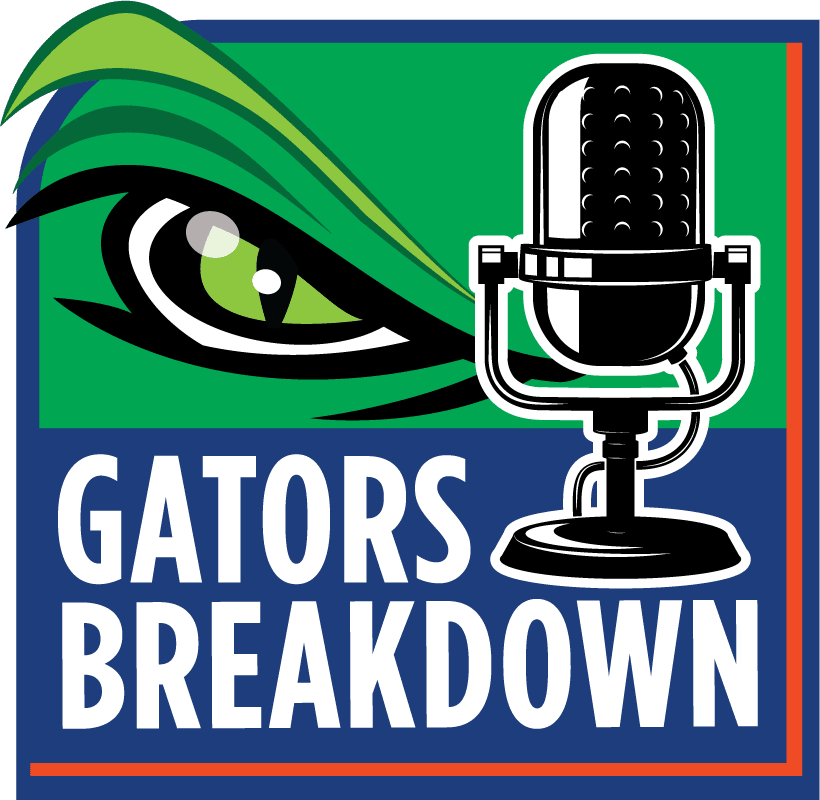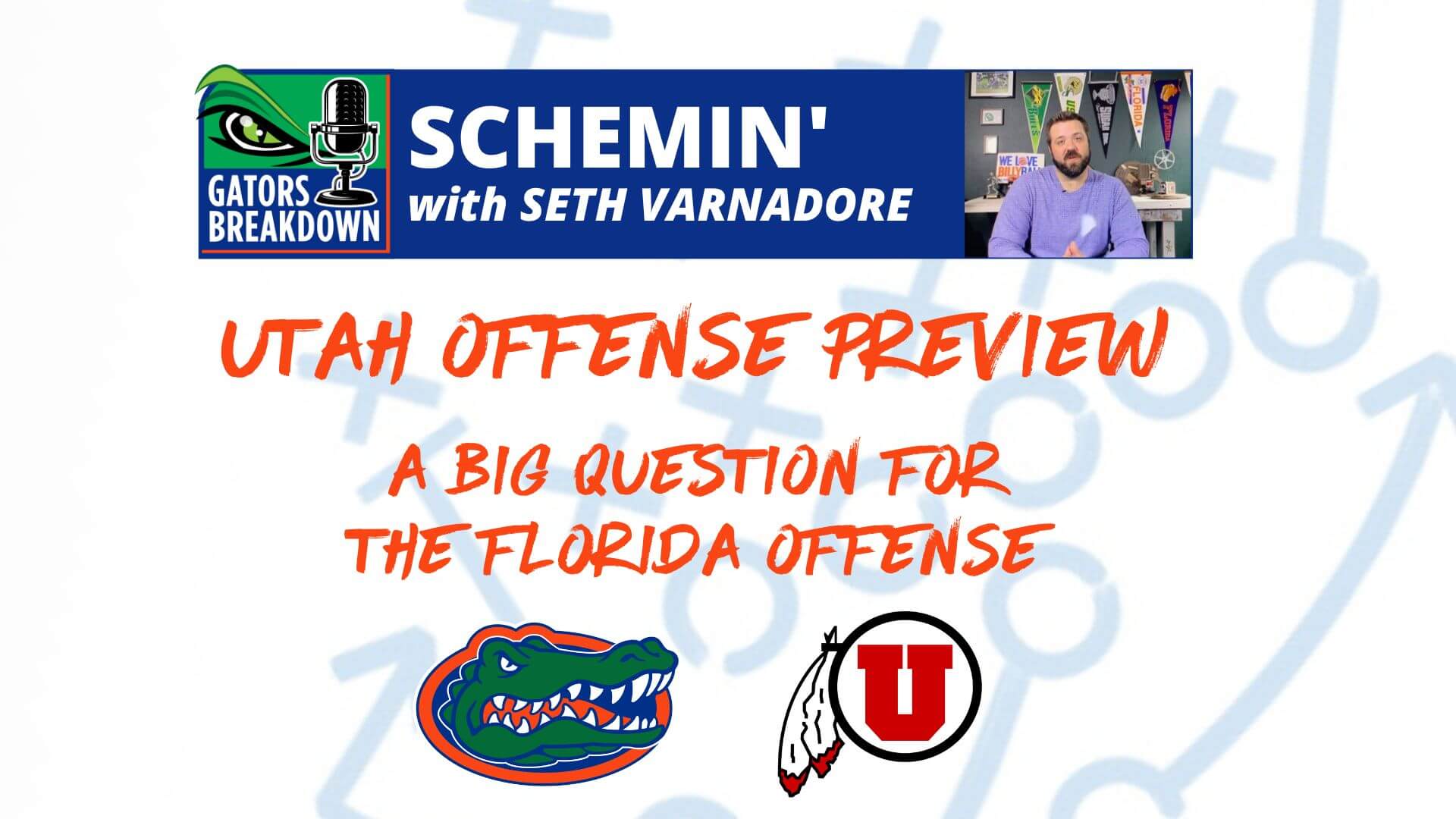For those of you that don’t know me, I’m Seth Varnadore. I coached football at the high school and college level for nine years. When I left coaching, I began writing and making videos about football scheme on my Youtube channel Varnadore Films.
I’m really excited by the opportunity to work with Dave and Gators Breakdown for this upcoming season. Each week, I’ll be going through a few plays from the previous game and breaking them down from a schematic perspective. To start, we’ll do a bit of a Utah preview. I’ll take a look at a few of the Utes favorite concepts on offense, and big question that the Florida offense must answer this season.
Utah Offense
In my preview of Utah last season, I wrote that the Utah offense was dynamic and presented some challenges to any defense. I believe that still holds true. They are somewhat uniquely built in terms of the modern college game. They shift and motion a lot pre-snap. They also use a lot of condensed formation to get the defense in tight. Those condensed formations coupled with how often they use two tight ends make it easy to see why Utah always seems to be able to run the ball.
As Florida saw last year, it can be extremely difficult to match up with two dynamic tight ends.One of those tight ends, Dalton Kincaid, is gone and was a first round draft pick. Interestingly enough, it wasn’t Kincaid but Brant Kuithe who tortured the Gators last season. Kuithe had nine catches for 105 yards and a touchdown in the opener last season. One of Kuite’s biggest catches came on a concept that Utah set up earlier in the game.
The stick concept is a very popular quick game concept that you see all across football. The combination can be run with two, three, and even four receivers to the same side. The idea is to create both a horizontal and vertical stretch. Typically one receiver occupies the deep third to their side, one occupies the flat and the third runs the stick route. This route is a six yard route that can convert based on coverage. If there is a hole the route can stop and turn into a hitch. If somebody comes to match the route, the receiver can turn out and run an out route.
Now there are different ways to run stick and Utah’s favorite version switches the responsibility of the first and second receiver. Utah prefers to run Stick Slot Fade, where the slot becomes the deep third player and the outside receiver becomes the flat player. This gives your slot a chance to win with a lot of room if you’re seeing man coverage.
Utah ran this early in the game against Florida last year and hit the stick route.
Utah would come back later in the game and run stick nod. The receiver running the stick will head fake as if he were breaking out and actually then get vertical.
Utah ran the nod out of a two receiver set and basically turned the play into four verticals. But the hesitation by the linebackers was all set up by the stick routes the Utes had been running all night.
Another pass concept to watch out for from Utah is the mesh concept. Mesh is a staple of the Air Raid and works against man or zone. Mesh typically involves two shallow crossing routes that come so close to each other that the receivers are sometimes taught to “low five” to get the correct spacing. The routes around those two can be tagged with a variety of other routes. Some of the more common tags are a spot route over the ball and wheel route by the back.
Utah runs mesh in a variety of ways. There seems to alway be somebody coming over the ball, either on a spot or a dig. They often tag a wheel in there as well, though not always to the back. Below are a few examples of the Utes mesh.
The funny thing about the Utah offense is that it isn’t all that dissimilar to the Florida offense. Utah likes to run wide zone, duo and some gap schemes just like the Gators do. Florida also runs stick and mesh. These are bread and butter passing schemes for the Utes and even if we don’t see Cam Rising, I’d bet we see those concepts.
A Big Question for the Gators Offense
Whether you loved him or were frustrated by him, one thing is for sure: Anthony Richardson attracted eyeballs. Not only did he attract the attention of tv viewers, national pundits and NFL scouts but he also attracted the eyes of opposing defenders every week.
This was especially true on the backside of run plays. The threat of him keeping the ball had to be accounted for unless you wanted to give up an explosive run.
While Florida gives itself a chance at a good play formationally with the tackle over, you can see the threat of AR keeping the ball holds or slows down the backside pursuit. Florida does not have the luxury of a Richardson level athlete at quarterback this season, so the big question is how can they protect the backside of their run game?
The first line of defense against a backside end closing hard is the play-action boot. If the end wants to fly down the line for the run game, the QB should have ample room to roll after he pulls the ball. Florida used some boot last year.
The DE tries to chase the back and it’s an easy pull and throw for the QB. Graham Mertz showed the ability to make throws on the move during his time at Wisconsin. Here’s a nice play-action rollout that Mertz drops in for a touchdown.
Let’s say the end stays home and you start getting hard backside pursuit from the backers and safeties coming downhill. Or maybe you keep getting two rushers off the backside to eliminate the boot. How can you protect your run game? You’ll have to dip into some intermediate play-action and second level RPOs. Second level RPOs are options that attack a second level defender. Florida ran a lot of simple box count RPOs for most of the season but they did try some second level RPOs early in the year. In the clip below, Kentucky basically brings three guys off the boundary side. Richardson is able to pull and make the throw to the open receiver.
Mertz also had success in his limited reps running some second-level RPOs at Wisconsin. Below he even gets to technically a third-level defender because Northwestern had the safety playing so low into the box.
Mertz also showed the ability to hit some intermediate play-action passes. These can also make linebackers and safeties pay for being over zealous in the run game.
The final thing Florida can do to protect their run game on the backside is to throw some screens that way. The screen game and the quick game are the two biggest areas in need of improvement in the passing game. If Florida can improve in those places their down to down efficiency numbers will take a nice leap upwards
I would love to see Florida add a tunnel screen on the backside of their wide zone. The LA Rams , with whom Billy Napier has some familiarity, , have paired some creative screens with
their wide zone in the post. Below is a great example of one Florida should steal.
The Gators will have to be a little different on offense this year, but they can still be successful. This first game against Utah should give us some good info. While I don’t expect the Gators to be perfect, I also don’t think Utah is great on defense. They probably won’t be in the top five of defenses that Florida will face this season. If you aren’t able to have some success against them, it could be a long season.
Defensively, the Utes are well coached and tough, but they aren’t particularly explosive. I believe that Utah has been built to bully the PAC-12 but that roster construction doesn’t work as well outside of conference. Utah hasn’t beaten a Power 5 team out of conference since the 2017 Zaxby’s Heart of Dallas Bowl against West Virginia. Against Pac-12 teams since 2017, Utah gives up an average of 3.55 yards per rush. That mark would be top 25 nationally most seasons. Against non-conference Power 5 teams, Utah allows 4.8 yards per rush. That would rank around 100th in most years. In their last four Power 5 out of conference games, Utah is allowing 6.24 yards per rush. It may be a result of a small sample size but it certainly seems like the Utah run defense is vulnerable outside of the PAC 12.
Offensively, a lot will depend on Cam Rising’s health. Utah is still able to run the ball for the most part against anybody. The last two seasons they have been top ten in yards per carry. Their in conference average would be a top five mark, while their out of conference averages are still very good being 33rd and 22nd respectively. Florida actually did a decent job against the Utah backs last year limiting them to 4.35 yards per carry, a full yard under their season average. However, Cam Rising was able to counteract that with some timely runs as he picked up 91 yards on the ground. He is great at escaping the pocket and finding the open receiver or tucking it to pick up crucial yards. If he plays, will that element of his game be eliminated? If so, that would help the Gators immensely. Utah again has a great stable of backs and some talent at tight end. They aren’t especially explosive at WR and Florida should be able to play some more man and load up the box.
You never know exactly what you are going to get in game one, and these two teams are somewhat similar schematically. Even though the game is on the road, I think Florida has a great shot to win. Florida will be breaking in a lot of new players but if those guys live up to expectations, the Gators could get a big win in primetime to kick off the season.


Seth,
Thanks for the great breakdown! Do you expect Florida’s interior defensive size to present any special issues?
Thanks.